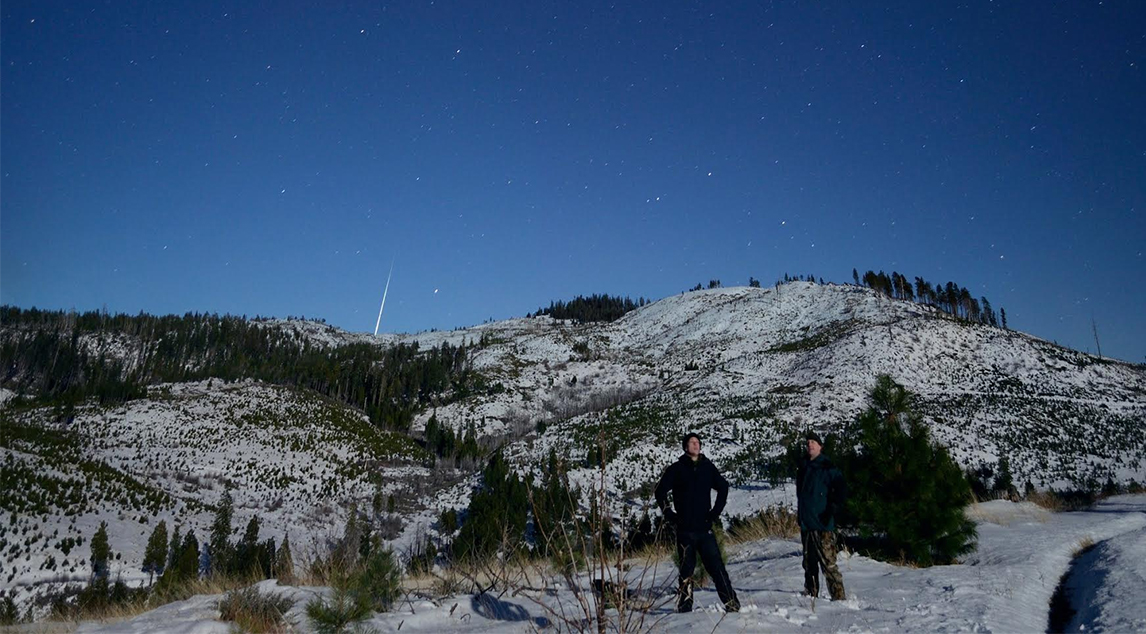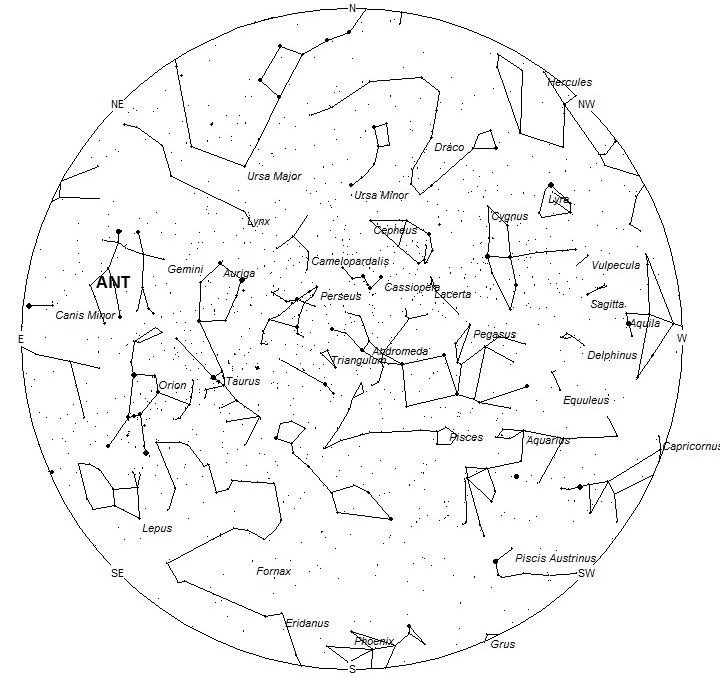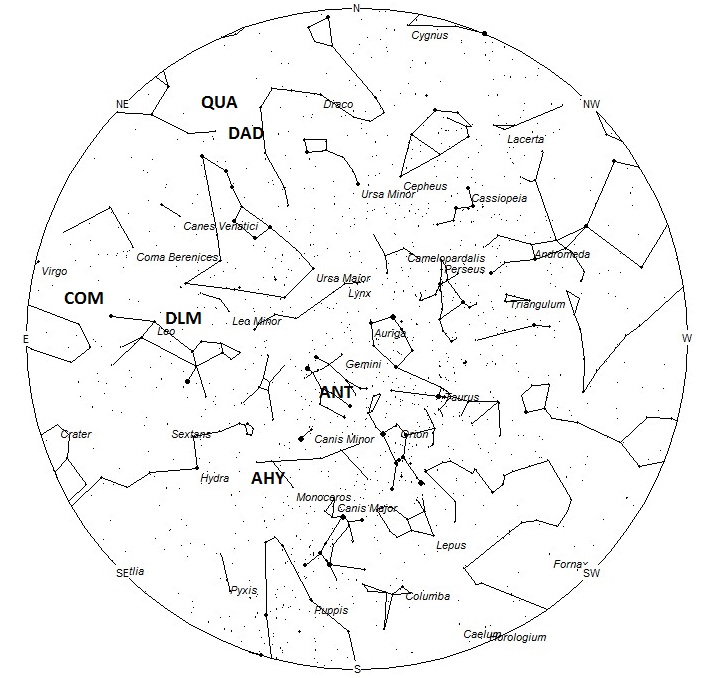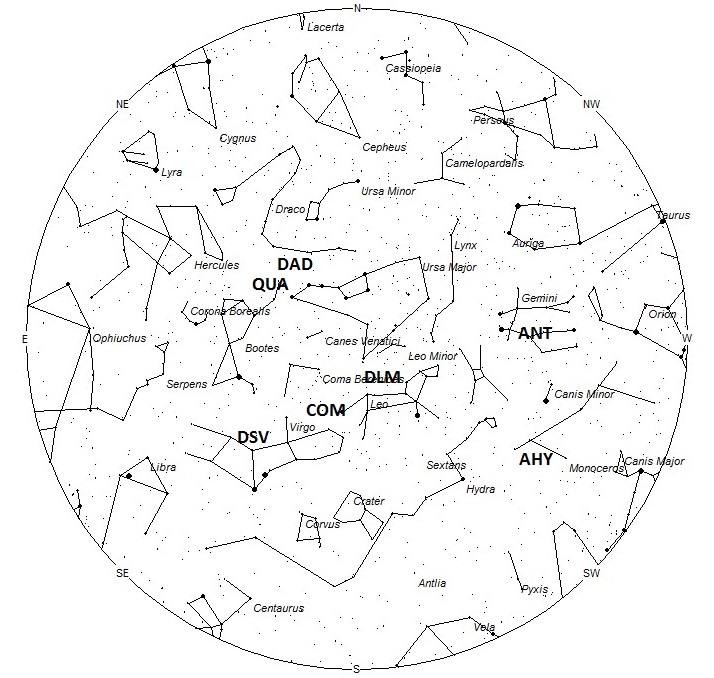
– Dec. 14th 2013, 3:08am PST © Dan McBride
During this period the moon reaches its new phase on Thursday December 29th. At this time the moon will be located near the sun and will not be visible at night. This weekend the waning crescent moon will rise during the early morning hours and will not cause any problems due to the thin phase. The estimated total hourly meteor rates for evening observers this week is near 4 as seen from mid-northern latitudes (45N) and 3 as seen from tropical southern locations (25S). For morning observers the estimated total hourly rates should be near 15 as seen from mid-northern latitudes (45N) and 12 as seen from tropical southern locations (25S). The actual rates will also depend on factors such as personal light and motion perception, local weather conditions, alertness and experience in watching meteor activity. Note that the hourly rates listed below are estimates as viewed from dark sky sites away from urban light sources. Observers viewing from urban areas will see less activity as only the brightest meteors will be visible from such locations.
The radiant (the area of the sky where meteors appear to shoot from) positions and rates listed below are exact for Saturday night/Sunday morning December 24/25. These positions do not change greatly day to day so the listed coordinates may be used during this entire period. Most star atlases (available at science stores and planetariums) will provide maps with grid lines of the celestial coordinates so that you may find out exactly where these positions are located in the sky. A planisphere or computer planetarium program is also useful in showing the sky at any time of night on any date of the year. Activity from each radiant is best seen when it is positioned highest in the sky, either due north or south along the meridian, depending on your latitude. It must be remembered that meteor activity is rarely seen at the radiant position. Rather they shoot outwards from the radiant so it is best to center your field of view so that the radiant lies at the edge and not the center. Viewing there will allow you to easily trace the path of each meteor back to the radiant (if it is a shower member) or in another direction if it is a sporadic. Meteor activity is not seen from radiants that are located below the horizon. The positions below are listed in a west to east manner in order of right ascension (celestial longitude). The positions listed first are located further west therefore are accessible earlier in the night while those listed further down the list rise later in the night.
These sources of meteoric activity are expected to be active this week.
Now that the activity from particles produced by comet 2P/Encke have ceased encountering the Earth, the Taurid showers for 2016 are over and we resume reporting activity from the Anthelion (ANT) radiant. This is not a true radiant but rather activity caused by the Earth’s motion through space. As the Earth revolves around the sun it encounters particles orbiting in a pro-grade motion that are approaching their perihelion point. They all appear to be radiating from an area near the opposition point of the sun, hence the name Anthelion. These were once recorded as separate showers throughout the year but it is now suggested to bin them into their category separate from true showers and sporadics. There are several lists that have the Chi Orionids currently active, but we include them with the Anthelions as the celestial positions overlap. This radiant is a very large oval some thirty degrees wide by fifteen degrees high. Activity from this radiant can appear from more than one constellation. The position listed here is for the center of the radiant which is currently located at 07:04 (106) +22. This position lies in central Gemini, 3 degrees west of the 4th magnitude star known as Wasat (delta Geminorum). Since the Anthelion radiant is so large, activity may also appear from eastern Taurus, northeastern Orion, western Cancer, and Canis Minor as well as western Gemini. This radiant is best placed near 0100 Local Standard Time (LST) when it lies on the meridian and is highest in the sky. Rates at this time should be near 2 per hour as seen from the northern hemisphere and 1 per hour from south of the equator. With an entry velocity of 30 km/sec., the average Anthelion meteor would be of slow velocity.
The Alpha Hydrids (AHY) were discovered by Dr. Peter Brown and other members of the Department of Physics and Astronomy, University of Western Ontario, London, Ontario Canada. They were using a meteoroid stream survey from the Canadian Meteor Orbit Radar to isolate radiants. This shower is active from December 22nd through January 7th with peak activity occurring on December 31st. The radiant is currently located at 08:00 (120) -06. This position lies in southeastern Canis Minor, 12 degrees southeast of the zero magnitude star named Procyon (alpha Canis Minoris). Rates would most likely be near less than one per hour, no matter your location. The Alpha Hydrids are best seen near 0200 LST when the radiant lies highest above the horizon. At 43 km/sec. the Alpha Hydrids produce mostly meteors of medium velocity.
Studies by the IMO’s Sirko Molau of video data obtained from Australian cameras has confirmed part of the Puppid-Velid complex that is active from December 27-30. The c Velids (CVE) peak on December 29th from a radiant located at 09:20 (140) -54. This position lies in southern Vela, just north of the position occupied by the 2nd magnitude star known as Markeb (Kappa Velorum). Due to the far southern declination (celestial latitude) these meteors are only visible from the northern tropics southward. They are best seen near 0300 LST when the radiant lies highest above the horizon. Hourly rates at maximum would likely be less than 1 as seen from the northern hemisphere and 1 as seen south of the equator. At 39 km/sec. the c Velids would produce mostly meteors of medium velocity.
The December Leonis Minorids (DLM) are a shower of long duration active from December 6th through January 18th. Maximum occurs near December 21st when rates may reach 3 an hour and this source is the strongest in the sky, except for the Ursids on the 22nd. The radiant is currently located at 11:06 (166) +27. This position lies on the border of Leo and Leo Minor. The 3rd magnitude star known as Zosma (delta Leonis) lies 6 degrees to the southeast. These meteors are best seen near 0500 LST when the radiant lies highest above the horizon. At 63 km/sec. the December Leonis Minorids produce mostly swift meteors. These meteors are not well seen from the southern hemisphere.
The Coma Berenicids (COM) are best seen from December 24 through January 3. Maximum activity occurs on December 31st when this shower is the fourth strongest in the sky. The current radiant position lies at 12:16 (184) +15. This position lies southwestern Coma Berenices, 5 degrees east of the 2nd magnitude star known as Denebola (beta Leonis). Current hourly rates should be less than 1 per hour no matter your location. These meteors are best seen near 0600 LST when the radiant lies highest above the horizon. At 69 km/sec. The Coma Berenicids would produce mostly swift meteors.
The December sigma Virginids (DSV) was discovered by John Greaves using the data of SonotaCo. IMO video cameras confirmed that this source is active during most of December. Visual observers have their best chance at catching these meteors from December 17-30. Peak rates occur near December 24th. The current radiant location is at 13:52 (208) +04 which places it in northern Virgo, 4 degrees northwest of the 4th magnitude star known as tau Virginis. Current hourly rates should be near 1 no matter your location. These meteors are best seen during the last dark hour before dawn, when the radiant lies highest above the horizon in a dark sky. At 68 km/sec. the December Sigma Virginids would produce mostly swift meteors.
The Alpha Draconids (DAD) are strange in that they have two activity periods. One is December 5-18 and the other is December 26-January 1. The maximum of the 2nd period occurs on December 30th when the radiant lies at 14:51 (223) +54. This position actually lies in extreme northern Bootes, 4 degrees northeast of the 4th magnitude star known as Asellus Primus (Theta Bootis). These meteors are best seen during the last dark hour before dawn, when the radiant lies highest above the horizon in a dark sky. Hourly rates, no matter your location, would most likely be less than 1, even at maximum activity. At 42 km/sec. the Alpha Draconids would produce mostly medium velocity meteors. It should be noted that this position is close to that of early Quadrantids and care should be taken to separate these two sources.
The Quadrantids (QUA) or January Bootids are active from December 30 through January 12th. A sharp maximum is predicted to occur near 1400 Universal Time on the 3rd. This corresponds to near dawn for western North America. Maximum rates are unpredictable for this shower. They can range anywhere from 25 to 100 per hour. Most observers will seen near 25 per hour before dawn. If you are extremely lucky the maximum will occur just before dawn with the radiant high in the sky. This is when counts will reach triple digits. At maximum the radiant is located at 15:24 (231) +49. This position lies in a barren region of extreme northern Bootes, ten degrees northeast of the fourth magnitude star Beta Bootis. As seen from the northern hemisphere, this area of the sky lies close to the northern horizon during the evening hours. Only after midnight does the radiant rise high into the northeastern sky. As seen from the southern hemisphere, this radiant is poorly placed as it only clears the northeastern horizon just before the start of morning twilight. Observers near the equator are a bit better off as the radiant rises at least 1 hour before the start of morning twilight. At 41 km/sec. the Quadrantids produce meteors of medium velocity. During exceptional activity some Quadrantid fireballs may be witnessed. Rates away from the night of maximum are poor, especially near the extremes of the activity period.
As seen from the mid-northern hemisphere (45N) one would expect to see approximately 10 sporadic meteors per hour during the last hour before dawn as seen from rural observing sites. Evening rates would be near 3 per hour. As seen from the tropical southern latitudes (25S), morning rates would be near 8 per hour as seen from rural observing sites and 2 per hour during the evening hours. Locations between these two extremes would see activity between the listed figures.
| SHOWER | DATE OF MAXIMUM ACTIVITY | CELESTIAL POSITION | ENTRY VELOCITY | CULMINATION | HOURLY RATE | CLASS |
| RA (RA in Deg.) DEC | Km/Sec | Local Standard Time | North-South | |||
| Anthelion (ANT) | – | 07:04 (106) +22 | 30 | 01:00 | 2 – 1 | II |
| Alpha Hydrids (AHY) | Dec 31 | 08:00 (120) -06 | 43 | 02:00 | <1 – <1 | IV |
| c Velids (CVE) | Dec 29 | 09:20 (140) -54 | 39 | 03:00 | <1 – 1 | IV |
| Dec. Leonis Minorids (DLM) | Dec 21 | 11:06 (166) +27 | 63 | 05:00 | 2 – 1 | II |
| Coma Berenicids (COM) | Dec 31 | 12:16 (184) +15 | 70 | 06:00 | <1 – <1 | IV |
| Dec. Sigma Virginids (DSV) | Dec 24 | 13:52 (208) +04 | 68 | 08:00 | 1 – 1 | IV |
| Dec. Alpha Draconids (DAD) | Dec 30 | 14:51 (223) +54 | 42 | 09:00 | <1 – <1 | IV |
| Quadrantids (QUA) | Jan 03 | 15:24 (231) +49 | 41 | 10:00 | <1 – <1 | I |
 American Meteor Society
American Meteor Society



22nd DEC 2016. 8.50pm Lancashire, England. Saw a fireball burning up in the sky, breaking into several pieces & turning brilliant white. Traveling NE at quite a high angle of attack.
About !5 minutes ago Meteor shower from south pacific towards the North Hemesphere…..Above The pacific Ocean….viewed from El Salvador…
I saw a burning ball plummeted down in lower poconos on Dec. 27 between 7:30 and 8:30am. Got 2 pictures of it
Just saw a slow moving meteor in Canaan, MA.